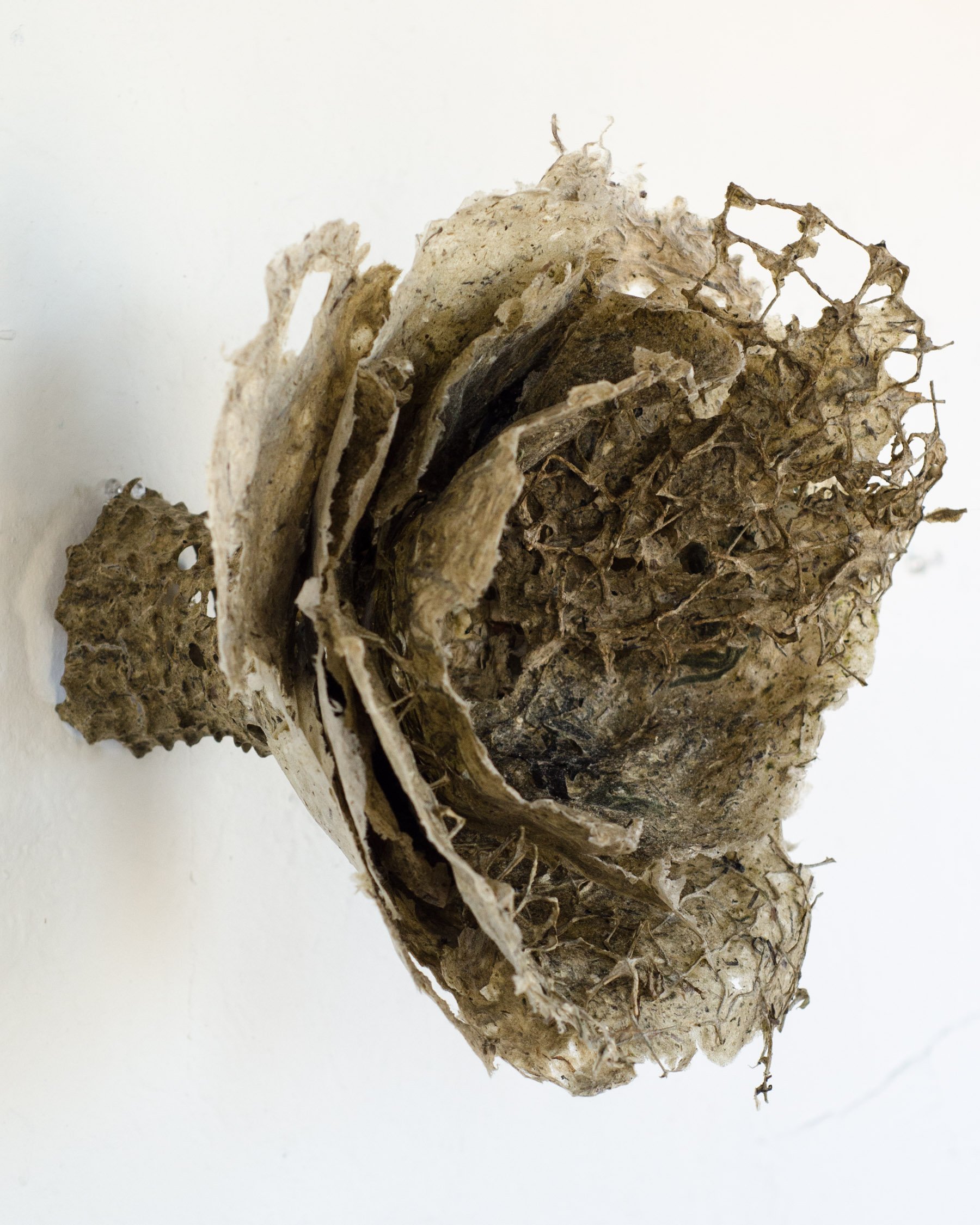Constructions
Constructions combine material and site research, resulting in a sculptural binding of papers made from collected seaweed, pondweeds, plants, and river muds.
Each work is a study of materials found in landscapes impacted by pollution and ecological distress. Sites have agricultural waste, troublesome seaweed and plant species, and polluted river mud, materials that are processed into paper pulp. The wet, artist-made sheets are dried and formed to allow the material characteristics to speak. Peering through the side of the reams, one can see the crevices and caves formed by the cockled paper. Shapes echo book pages and industrial works such as levee slopes and nuclear cooling towers, and present layers of the material.
Exhibited at: Fitchburg Art Museum, Homegrown Gallery, Glassell Gallery, Baton Rouge LA, “Paper in Space,” Haggerty Gallery, University of Dallas, TX, AS220 Project Space, Providence RI, 1890 Bryant Street Studios, San Francisco CA
Rome Point Seaweed Constructions, artist-made paper from seaweed (Codium fragile) and abaca, fencing, wire, 6 pieces at approx. 12 x 12 x 10 in. each, 2021
A series of wall sculptures made from seaweed paper, that tells a story of industry interwoven with a species from afar, and how humans shape the waters more than we know.
Rome Point is located in Rhode Island, USA. It was a summer fishing place for thousands of years for the Narragansett tribe. In the 1970s, the site was considered for a UNC nuclear energy plant, with cooling towers that would circulate hot water into the cold ocean waters, raising the temperature of the Bay. Through community advocacy, this did not happen.
The artist made the paper from Rome Point’s Codium fragile seaweed, which arrived to coastal North America in the 1950s, in ship ballast water from Japan. It outcompetes eel grass needed for shellfish, and is called an ‘invasive’ species by scientists. The form is influenced by nuclear cooling towers and the act binding together book pages. Rome Point Seaweed Constructions are inspired by these interconnections, circular systems, and ties between past, present, and future.
Water Chestnut Studies, 2021, wire, gilded metal leaf, artist-made paper from backyard flax, Trapa natans pondweed, 8 ½” x 9 ½” x 8” each
I first started making paper from water chestnut (Trapa natans) in 2018 for Blackstone Watershed Papers and have since incorporated this fiber into the Ebb and Flow IX: Nashua River installation.
People label this pondweed as ‘invasive,’ but I like to call plants from other places as ‘travelers,’ ‘displaced,’ or ‘troublesome.’ The fact is, these opportunistic plants are filling an ecological niche in a site already disturbed by humans. They tell the story of what has happened in a place.
Water chestnut is taking over several freshwater ponds in Rhode Island, ponds that are so polluted that one can’t swim safely in them. Water chestnut also is great at drawing up metals in waterways. This sculptural installation is a response, and uses the pondweed fiber as paper pulp.
Bagasse Construction, Handmade Paper from Bagasse (sugarcane) Fiber, 8" x 17" x 11", 2011
Bagasse is the fiber left over from the industrial process of sugar cane production, a major crop in Louisiana. Bagasse paper was first made in Louisiana in the 1800s. I went to Alma, Louisiana to obtain the bagasse fiber from the Alma Plantation, one of the 11 remaining sugar mills in Louisiana. Bagasse is used to fuel the processing plant during harvesting season, but still each year about 60 percent of it is unused and discarded.
Mississippi River Mud Construction, Handmade Paper, Mississippi River Mud, 24" x 11" x 2" open, 2011
Seekonk River Mud Constructions, 63 in. x 144 in. x 7 in., 30 objects at 16” x 8” each, 2013
Installation of handmade paper sculptural books made from Seekonk River mud and recycled paper scrap.
Constructions of Problematic Plants of Coastal Rhode Island, Handmade Paper from Phragmites Australis, Japanese Knotweed, and Codium Fragile – 2013 - A variable installation of 15 book constructions.














